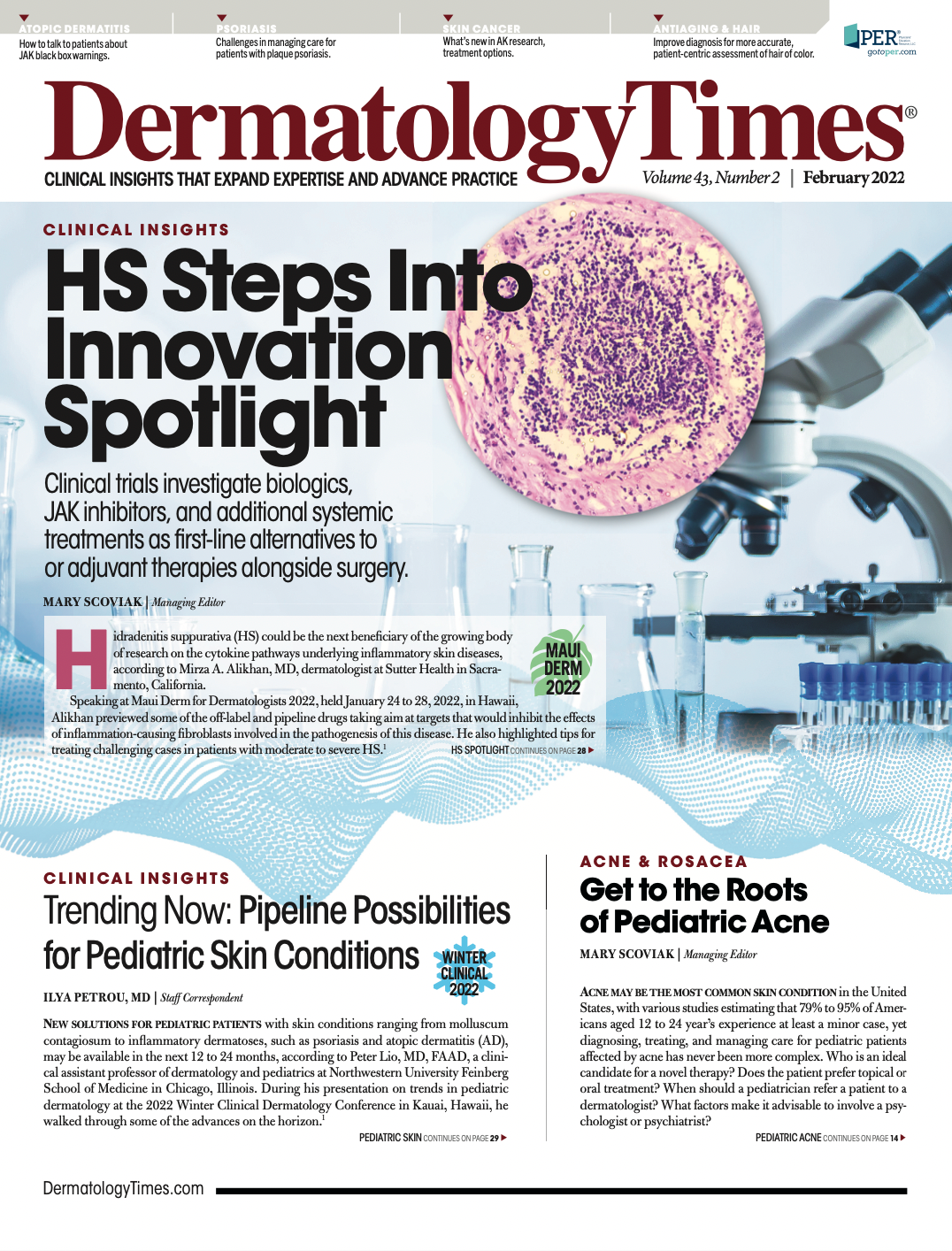- Case-Based Roundtable
- General Dermatology
- Eczema
- Chronic Hand Eczema
- Alopecia
- Aesthetics
- Vitiligo
- COVID-19
- Actinic Keratosis
- Precision Medicine and Biologics
- Rare Disease
- Wound Care
- Rosacea
- Psoriasis
- Psoriatic Arthritis
- Atopic Dermatitis
- Melasma
- NP and PA
- Skin Cancer
- Hidradenitis Suppurativa
- Drug Watch
- Pigmentary Disorders
- Acne
- Pediatric Dermatology
- Practice Management
- Prurigo Nodularis
- Buy-and-Bill
Publication
Article
Dermatology Times
How to Explain JAK Inhibitor Warnings to Patients
Author(s):
Experts outline strategies for patient conversations around the black box warning.
Janus kinase (JAK) inhibitors continue to make headlines in the pipeline and armamentarium for atopic dermatitis (AD) treatment. An FDA-issued black box warning, however, creates a challenge for dermatologists, who must explain the risks and benefits with patients. Based on data from a long term study of oral tofacitinib (Xeljanz), the boxed warning applies to the first topical JAK inhibitor approved for AD, ruxolitinib (Opzelura; Incyte), along with the oral JAK inhibitors currently in the pipeline, and poses a challenge in discussing the risks and benefits of these treatments with patients.1
As part of an exclusive DermView series supported by Incyte, Linda Stein Gold, MD, director of dermatology clinical research and division head of dermatology at Henry Ford Health System in Detroit, Michigan, and Matthew Zirwas, MD, founder of Bexley Dermatology in Ohio, delved into safety and tolerability data for JAK inhibitors and how to approach that conversation.
Stein Gold stressed the importance of giving the warning context when talking with patients. “There was actually a safety study that was requested by the FDA, and this was for tofacitinib. They had looked at 2 different doses of tofacitinib, both the lower dose [5 mg twice a day] and the higher dose [10 mg twice a day], for safety,” Stein Gold said. “They did this in comparison [with] 2 TNF inhibitors, adalimumab [Humira] and etanercept [Enbrel]. The ques- tion was ‘Is tofacitinib noninferior in terms of the safety outcome to the TNF [tumor necrosis fac- tor] inhibitors?’ The primary end point here was looking at a postmarketing safety study—looking at major adverse cardiac events and malignancies. The bottom line from this study was that tofacitinib was not found to be comparable. In fact, it was found to have an increased safety warning for both of these areas. From this, the FDA has actually broadened the box warning and the language to not just tofacitinib but [also] the oral JAK inhibitors—all of them—as well as the topical.”
It is important to tell patients that the FDA broadened this warning without additional safety data on new and upcoming medications, Stein Gold said: “This is interesting because the study was only with tofacitinib, yet the box warning was applied to the other oral JAK inhibitors as well as the topical JAK inhibitor.”
The FDA noted that the other oral JAK inhibitors had not been studied in comparably large safety clinical trials but were included in the warning due to sharing mechanisms of action with tofacitinib. Oral ruxolitinib was not included in the statement because it is not indicated for inflammatory conditions. Additionally, topical ruxolitinib was not mentioned.
Patients also need to understand that the risks outlined on the label are not equally applicable to all JAK inhibitors or all treatment regimens. “We do know that at least some of the [adverse effects; AEs] associated with systemic JAKs are very dose related,” Zirwas said. “Reducing the dose certainly should reduce the risk of immu- nosuppression. We don’t know as much about if it really reduces the potential thrombotic risk.”
For topicals, Zirwas said, dermatologists can cite numbers to give patients more information: “There was a pretty good study that said about 6% of topically applied ruxolitinib will get absorbed systemically, which is a small number, but you also have to remember that whenever you’re talking about a 1.5% topical, that means there’s 15 mg in every 1 g of medication. The key takeaway is that 94% of the topically applied ruxolitinib does not show up in the patient’s system.”
Body surface area (BSA) also affects systemic absorption. “In patients applying topical ruxolitinib to 25% BSA, the average systemic exposure was still well below the oral dosing it was compared [with]. Whenever they looked at patients that were less than 20% [BSA], the plasma concentrations were as you would’ve expected, about 90% lower than with oral exposure,” Zirwas said.
Stein Gold noted that 2 phase 3 trials looked at patients with 3% to 20% BSA affected.2 However, she cautioned, the more BSA that is treated, the higher the levels of systemic absorption.
“If you push it and instead of doing 20%, you do 60%, you could potentially get a level that would be similar to what you would experience taking this drug orally,” she said. She noted that maximum use studies looked at patients with a much higher BSA than the clinical trials did.
Although dermatologists can reassure patients that these options have a lower level of systemic absorption, they also need to offer clear, straightforward guidance about what is—and is not—known. “The thing that makes it difficult is when we look back at things like the tacrolimus box warning or the pimecrolimus box warning, we knew that there was zero systemic absorp- tion,” Zirwas said. “You couldn’t even detect it in the blood unless somebody had Netherton syndrome. There is some systemic absorption here—low, at 6%—but we know that the AEs of JAKs are dose related. It is conceivable that there’s a little bit of immunosuppression. Do I personally think there is? Probably not. It’s hard for me to believe that the amount that’s getting into the blood with topical ruxolitinib is enough that it really is immunosuppressive.”
“Clotting risk is another concern,” Zirwas continued. “Maybe this increases your risk of a blood clot by 1%. Now, if your risk at baseline is 1 in 1000 per year and that increases it by 1%, it’s 1 in 999 people vs 1 in 1000. That’s a not very meaningful effect, but it might be zero, it might be a tiny increase. I don’t think this has any effect on how your blood would clot, but I can’t tell you 100% that it has zero risk. It may have a very small effect; we just don’t really know. It is conceivable that there’s a tiny increase in the risk of venous thromboembolic events. Do I think that there is? Probably not, because the absorption— the systemic exposure—is so low, but it’s at least possible, right? I can’t say to a patient, ‘Look, this doesn’t even get into your blood.’ We don’t have big enough numbers of patients to be 100% sure whether there’s risk here or not.”
Research is more robust on the issue of toler- ability. “I do think of [safety and tolerability] as 2 totally different issues,” Zirwas said. “We know, for example, that the PDE4 [phosphodiesterase 4] inhibitor that’s been on the market for a while is extremely safe but doesn’t always have the best tolerability. I have not seen any tolerability issueswith topical ruxolitinib. I haven’t had anybody complain of any burning, stinging, any applica- tion type reactions, or any tolerability issues.”
Stein Gold added that the issue should be discussed with patients when looking at a topical JAK inhibitor instead of a topical steroid. “So often when we think about a nonsteroidal product, we think about a trade-off,” she said. “It’s safe, but it might have a little bit of stinging and burning. I think we’ve seen that with our other nonsteroidals both in [AD and] psoriasis. Ruxolitinib is one where we really don’t see that stinging and burning that we might expect with a nonsteroidal. It’s pretty well tolerated even at day 1.”
Zirwas encouraged dermatologists to have a dialogue with patients who are good candidates for a topical JAK inhibitor about some of the safety concerns that exist with other treatment options but not with JAK inhibition. “Whenever I prescribe it, the talk usually goes like this: ‘We’re going to prescribe you this new medication. It is not a steroid. You don’t have to worry about thinning of the skin or anything like that. You don’t have to take big breaks from it. You’re going to use it until your skin gets cleared up, then you stop using it. You start to break out again, you start to use it again.’”
Disclosures
Stein Gold is an investigator/adviser for AbbVie; Arcutis Biotherapeutics; Bris- tol Myers Squibb; Dermavant Sciences, Inc; Galderma; Incyte Corporation; LEO Pharma; Ortho Dermatologics; and UBB.
Zirwas was compensated by Incyte Corporation.
References
1 FDA requires warnings about increased risk of serious heart-related events, can- cer, blood clots, and death for JAK inhibitors that treat certain chronic inflamma- tory conditions. FDA. February 4, 2021. Updated December 7, 2021. Accessed January 6, 2022. https://www.fda.gov/drugs/drug-safety-and-availability/fda- requires-warnings-about-increased-risk-serious-heart-related-events-cancer- blood-clots-and-death
2. Papp K, Szepietowski JC, Kircik L, et al. Efficacy and safety of ruxolitinib cream for the treatment of atopic dermatitis: results from 2 phase 3, randomized, dou- ble-blind studies. J Am Acad Dermatol. 2021;85(4):863-872. doi:10.1016/j. jaad.2021.04.085





